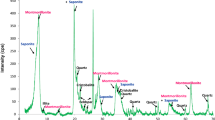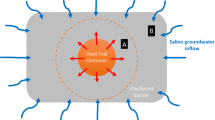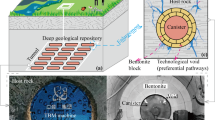Abstract
Compacted bentonite–sand mixtures are commonly considered as the key materials for the construction of engineered barrier systems (EBSs) in deep geological repositories (DGRs) in Canada and other countries. These bentonite-based barriers can be simultaneously exposed to a wide range of chemical and thermal (nuclear waste heat decay) conditions of underground water. Thus, an understanding of the effects of groundwater chemistry and temperature and their interactions on the changes in the swelling properties as well as the microstructure of bentonite-based barriers is essential for assessing the durability and safety of an EBS in a DGR. This study experimentally investigates the impact of a Canadian deep underground water chemistry (C; total dissolved solids up to 300 g/L), temperature (T; 23 °C, 40 °C, and 80 °C), and the coupled effects of C and T on the swelling properties and microstructure of bentonite–sand barrier mixtures (30 to 70% by weight). The results show that the groundwater chemistry of southwestern Ontario (Canada) has a significant impact on the swelling characteristics of the examined bentonite–sand material. The swelling ability significantly decreases with respect to the groundwater chemistry. The mineralogical composition of the bentonite changes. Most of the Na-montmorillonite is mainly transformed to Ca-montmorillonite and traces of illite with a lower swelling capacity when the bentonite–sand barrier material is exposed mixed to saline water solutions. The temperature (alone) has a limited effect. However, the temperature–groundwater chemistry interactions significantly affect the swelling capacity of the studied bentonite–sand material. Future safety assessments and the final engineering design of engineered barriers for DGRs in Ontario should take into consideration the possibility of the long-term deterioration of bentonite–sand barriers from chemical attacks and/or thermochemical attacks induced by the high salinity of the groundwater and by simultaneous impact of the chemistry of the groundwater and the heat generated by the nuclear wastes, respectively.












Similar content being viewed by others
References
ANDRA (2005) Dossier 2005 Argile. Les recherches de l’Andra sur le stockage géologique des déchets radioactifs à haute activité et à vie longue. Collection les rapports
Basma AA, Al-Homoud AS, Husein A (1995) Laboratory assessment of swelling pressure of expansive soils. Appl Clay Sci 9(5):355–368
Borgesson L, Chijimatsu M, Fujita T, Nguyen TS, Rutqvist J, Jing L (2001) Thermo-hydro-mechanical characterisation of a bentonite-based buffer material by laboratory tests and numerical back analyses. Int J Rock Mech Min Sci 38(1):95–104
Boudriche L, Calvet R, Hamdi B, Balard H (2012) Surface properties evolution of attapulgite by IGC analysis as a function of thermal treatment. Colloids Surf A Physicochem Eng Asp 399:1–10
Bradbury MH, Baeyens B (2002) Porewater chemistry in compacted re-saturated MX-80 bentonite: physicochemical characterisation and geochemical modelling. PSI Bericht 02–10, Villigen PSI and NTB 01–08, Nagra, Wettingen, Switzerland
Brunauer S, Emmett PH, Teller E (1938) Adsorption of gases in multimolecular layers. J Am Chem Soc 60(2):309–319
Castellanos E, Villar MV, Romero E, Lloret A, Gens A (2008) Chemical impact on the hydro-mechanical behaviour of high-density FEBEX bentonite. Phys Chem Earth 33:S516–S526
Cho WJ, Lee JO, Chun KS, Hahn DS (1999) Basic physicochemical properties of domestic bentonite for use as a buffer material in a high-level radioactive waste repository. J Korean Nucl Soc 31:39–50
Cho GC, Kim JS, Kwon SK, Sanchez M (2011) Geological storage of high level nuclear waste. KSCE J Civ Eng 15(4):721–737
Cui Y-J (2017) On the hydro-mechanical behaviour of MX80 bentonite-based materials. J Rock Mech Geotech Eng 9(3):565–574
Cui SL, Zhang HU, Zhang M (2012) Swelling characteristics of compacted GMZ bentonite–sand mixtures as a buffer/backfill material in China. Eng Geol 141–142:65–73
Dhawan S, Rao M (2012) Effect of heating and pore water salinity on the swelling characteristics of bentonite buffer. Clays in natural & engineered barriers for radioactive waste confinement. 4th international meeting – March 2010 – Nantes, France
Dogan M, Dogan AU, Yesilyurt F, Alaygut D, Buckner D, Wurster D (2007) Baseline studies of the clay minerals society special clays: specific surface area by the Brunauer Emmett Teller (BET) method. Clay Clay Miner 55(5):534–541
Dollar PS (1988) Geochemistry of formation waters, Southwestern Ontario, Canada and Southern Michigan, U.S.A. Implications for origin and evolution. M.Sc. Thesis. University of Waterloo, Canada
Drits V, Lindgreen H, Salyn A, Ylagan R, Mccarty D (1998) Semiquantitative determination of trans-vacant and cis-vacant 2:1 layers in illites and illite-smectites by thermal analysis and X-ray diffraction. Am Mineral 83:1188–1198
Eberl DD, Velde B, McCormick T (1993) Synthesis of illite-smectite from smectite at earth surface temperatures and high pH. Clay Miner 28:49–60
Estabragh AR, Khosravi F, Javadi AA (2016) Effect of thermal history on the properties of bentonite. Environ Earth Sci 75(8):657
Fall M, Nasir O, Nguyen TS (2012) Coupled hydromechanical modeling of gas migration in Ontario’s sedimentary rocks, potential host rocks for nuclear waste repositories. Canadian Geotechnical Conference – Geomanitoba 2012
Fall M, Nasir O, Nguyen S (2014) A coupled hydro-mechanical model for simulation of gas migration in host sedimentary rocks for nuclear waste repositories. Eng Geol 176:24–44
Garrels R (1984) Montmorillonite/illite stability diagrams. Clay Clay Miner 32(3):161–166
Ghadr S, Assadi-Langroudi A (2018) Structure-based hydro-mechanical properties of sand-bentonite composites. Eng Geol 235:53–63
Grim RE, Güven N (1978) Bentonites, geology, mineralogy, properties and uses, development in sedimentology, vol 24. Elsevier, Amsterdam
Guo G, Fall M (2018) Modelling of dilatancy-controlled gas flow in bentonite based materials with double porosity and double effective stress concepts. Eng Geol 243(4):253–271
Guo G, Fall M (2019) Modelling of preferential gas flow in heterogeneous and saturated bentonite based on phase field method. Comput Geotech 116:103206
He Y, Ye W-M, Chen Y-G, Chen B, Ye B, Cui Y-J (2016) Influence of pore fluid concentration on water retention properties of compacted GMZ01 bentonite. Appl Clay Sci 5(129):131–141
Heller-Kallai L (2013) Thermally modified clay minerals, in Developments in clay science, Vol. 5A, Handbook of clay science, 2d Ed., F. Bergaya and G. Lagaly Eds, Chapter 10.2, pp. 411–434, Elsevier, Amsterdam
Herbert HJ, Kasbohm J, Sprenger H, Fernández AM, Reichelt C (2008) Swelling pressures of MX-80 bentonite in solutions of different ionic strength. Phys Chem Earth 33:S327–S342
Jensen M, Lam T, Luhowy D, McLay J, Semec B, Frizzell R (2009) Ontario power generation’s proposed L&ILW deep geologic repository: an overview of geoscientific studies. Nuclear Waste Management Organization, GeoHalifax2009/GéoHalifax2009
Jeong E, Lim JM, Seo K-W, Lee Y-S (2011) Effects of physicochemical treatments of illite on the thermo-mechanical properties and thermal stability of illite/epoxy composites. J Ind Eng Chem 17:77–82
Jönsson B, Akesson T, Jönsson B, Meehdi S, Janiak J, Wallenberg R (2009) Structure and forces in bentonite MX-80. SKB Technical Report TR-09-06. Swedish Nuclear Fuel and Waste Management Company, Stockholm, Sweden
Justinavicius D, Poskas P, Narkuniene A (2016) Gas migration modelling in geological repository module in clay formation and sensitivity analysis. Eng Geol 213:158–168
Karnland O, Birgersson M (2006) Montmorillonite stability with respect to KBS-3 conditions. SKB Technical Report TR-06-11. Swedish Nuclear Fuel and Waste Management Company, Stockholm, Sweden
Kaufhold S, Dohrman R (2011) Stability of bentonites in salt solutions III—calcium hydroxide. Appl Clay Sci 51:300–307
Komarneni S, Ravella R, Park M (2005) Swelling mica-type clays: synthesis by NaCl melt method, NMR characterization and cation exchange selectivity. J Mater Chem 15:4241–4245
Lee OL, Kang IM, Cho WJ (2010) Smectite alteration and its influence on the barrier properties of smectite clay for a repository. Appl Clay Sci 47:99–104
Li Z, Su G, Zheng Q, Nguyen TS (2019) A dual-porosity model for the study of chemical effects on the swelling behaviour of MX-80 bentonite. Materials 12(10):1671
Mansa R, Huang C-T, Quintela A, Rocha F, Detellier C (2015) Preparation and characterization of novel clay/PLA nanocomposites. Appl Clay Sci 115:87–96
Mata C, Ledesma A (2003) Hydro-chemical behaviour of bentonite based mixtures in engineered barriers. In Proceedings of International Workshop on Large Scale Field Tests in Granite: Advances in Understanding and Research Needs, Sitges, Spain, 12–14 November 2003. Universitat Polite`cnicia de Catalunya- ENRESA. Sitges, Spain. Paper No. 22. Minerals 41, 162–177
Mitchell JK, Soga K (1993) Fundamentals of soil behavior, Book 2nd edition, Wiley
Moore DM, Reynolds RC (1989) X-ray diffraction and the identification and analysis of clay minerals. New York City: Oxford University press; Oxford
Morena GDL, Asensio L, Navarro V (2018) Intra-aggregate water content and void ratio model for MX-80 bentonites. Eng Geol 246:131–138
Morodome S, Kawamura K (2009) Swelling behavior of Na- and Ca-montmorillonite up to 150°C by in situ X-ray diffraction experiments. Clay Clay Miner 57:150–160
Nasir O, Fall M, Evgin E (2014a) A simulator for modeling of porosity and permeability changes in near field sedimentary host rocks under climate changes influences. Tunn Undergr Space Technol 42:122–135
Nasir O, Fall M, Nguyen S, Evgin E (2014b) Modeling of the thermo-hydro-mechanical-chemical response of Ontario sedimentary rocks to future glaciations. Can Geotech J. https://doi.org/10.1139/cgj-2013-0016
Navarro V, Yustres Á, Asensio L, Morena DLG, González-Arteaga J, Laurila T, Pintado X (2017) Modelling of compacted bentonite swelling accounting for salinity effects. Eng Geol 223(7):48–58
NWMO (2011a) Geosynthesis. Prepared by: Nuclear Waste Management Organization NWMO DGR-TR-2011-11
NWMO (2011b) OPG’s deep geological repository for low and intermediate level. Waste, regional hydrogeochemistry – Southern Ontario. NWMO DGR-TR-2011-12
NWMO (2012) Nuclear Waste Management Organization, Newsletter volume 10, issue 3 June
NWMO (2013) Website http://www.nwmo.ca/dgrprojectschedule
Ouellet-Plamondon C, Stasiak J, Al-Tabbaa A (2014) The effect of cationic, non-ionic and amphiphilic surfactants on the intercalation of bentonite. Colloids Surf A Physicochem Eng Asp 444:330–337
Priyanto D, Baumgartner P (2008) Volume-mass relationships of soil with fresh water and saline water solutions. Nuclear waste management organization, appendix D: technical report TR-2008-04
Pusch R (1982) Mineral-water interactions and their influence on the physical behaviour of highly compacted Na bentonite. Can Geotech J 19:381–387
Pusch R (1998) Backfilling with mixtures of bentonite/ballast materials or natural smectitic clay. SKB Technical Report. TR-98-16 Swedish Nuclear Fuel and Waste Management Company, Stockholm, Sweden
Pusch R (2000) On the effect of hot water vapor on MX-80 clay. Geodevelopment AB, Lund. Technical Report:TR-00-16, KSB
Pusch R (2001) Experimental study of the effect of high porewater salinity on the physical properties of a natural smectitic clay, SKB, Swedish Nuclear Fuel and Waste Management Co., Technical Report TR-01-07, KSB
Pusch R (2002) The buffer and backfill handbook. Part 1. SKB Technical Report TR-02-20. Swedish Nuclear Fuel and Waste Management Company, Stockholm, Sweden
Pusch R, Yong RN (2006) Microstructure of smectite clays and engineering performance. Book, CRC Press. Taylor & Francis, 332 pages
Quintessa (2011) Bentonite a review of key properties, processes and issues for consideration in the UK context QRS-1378ZG-1, Version 11, February
Rodwell WR, Horseman ST, Harris AW (1999) Gas migration and two-phase flow through engineered and geological barriers for a deep repository for radioactive waste. A Joint EC/NEA Status Report, EUR 19112 EN, Brussels
RWM (2003) Engineered barrier systems and the safety of deep geological repositories. Radioactive Waste Management, ISBN 92-64-18498-8
Rytwo G, Banin A, Nir S (1996) Exchange reactions in the Ca-Mg-Na montmorillonite system. Clay Clay Miner 44:276–285
Sällfors G, Öberg-Högsta A-L (2002) Determination of hydraulic conductivity of sand-bentonite mixtures for engineering purposes. Geotech Geol Eng 20(1):65–80
Sarkar G, Siddiqua S (2017) Preliminary studies of hydraulic and mechanical behavior of nanoparticle-based light backfill exposed to pore fluid salinity. J Hazard Toxic Radioact Waste 21(2):04016010
Siddiqua S, Blatz J, Siemens G (2011) Evaluation of the impact of pore fluid chemistry on the hydromechanical behaviour of clay-based sealing materials. Can Geotech J 48:199–121
Sing KSW (1982) Reporting physisorption data for gas/solid systems with special reference to the determination of surface area and porosity. Pure Appl Chem 54(11):22OI–22l8
Steefel C, Rutqvist J, Tsang CF, Liu HH, Sonnenthal E, Houseworth J, Birkholzer J (2010) Reactive transport and coupled THM processes in engineering barrier systems (EBS). Lawrence Berkeley national laboratory (LBNL), 09-10-2010
Teich-McGoldrick SL, Greathouse JA, Jové-Colon CF, Cygan RT (2015) Swelling properties of montmorillonite and beidellite clay minerals from molecular simulation: comparison of temperature, interlayer cation, and charge location effects. J Phys Chem C 119:20880–20891
Terzaghi K, Peck RB, Mesri G (1996) Soil mechanics in engineering practice, 3rd edn, pp 71–84
Thomas HR, Cleall PJ, Chandler N, Dixon D, Mitchell HP (2003) Water infiltration into a large-scale in-situ experiment in an underground research laboratory. Géotechnique 53(2):207–224
Ureana C, Azañón JM, Corpas F, Nieto F, León C, Pérez L (2013) Magnesium hydroxide, seawater and olive mill wastewater to reduce swelling potential and plasticity of bentonite soil. Constr Build Mater 45:289–297
Velde R, Renac C (1996) Smectite to illite conversion and K-Ar ages. Clay Miner 31:25–32
Villar MV, Lloret A (2004) Influence of temperature on the hydro-mechanical behaviour of a compacted bentonite. Appl Clay Sci 26:237–350
Wang CC, Juang LC, Lee CK, Hsu TC, Lee JF, Chao HP (2004) Effects of exchanged surfactant cations on the pore structure and adsorption characteristics of montmorillonite. J Colloid Interface Sci 280(1):27–35
Wang Q, Tan A, Cu YI, Delage P, Gatmiri B (2012) Experimental study on the swelling behaviour of bentonite/claystone mixture. Eng Geol 124:59–66
Wersin P, Johnson LH, McKinely IG (2007) Performance of the bentonite barrier at temperatures beyond 100°C: a critical review. Phys Chem Earth 32:780–788
World Nuclear Association (2014) Radioactive waste management. http://www.world-nuclear.org/info/Nuclear-Fuel-Cycle/Nuclear-Wastes/Radioactive-Waste-Management
Ye W-M, He Y, Chen Y-G, Chen B, Cui YJ (2016) Thermochemical effects on the smectite alteration of GMZ bentonite for deep geological repository. Environ Earth Sci 75:906
Zhang F, Ye WM, Chen YG, Chen B, Cui YJ (2016) Influences of salt solution concentration and vertical stress during saturation on the volume change behavior of compacted GMZ01 bentonite. Eng Geol 207:48–55
Zhang C, Chen Q, Qin X, Hong B, Zhang Q (2017) In-situ stress and fracture characterization of a candidate repository for spent nuclear fuel in Gansu, northwestern China. Eng Geol 231:218–229
Author information
Authors and Affiliations
Corresponding author
Rights and permissions
About this article
Cite this article
Shehata, A., Fall, M., Detellier, C. et al. Effect of groundwater chemistry and temperature on swelling and microstructural properties of sand–bentonite for barriers of radioactive waste repositories. Bull Eng Geol Environ 80, 1857–1873 (2021). https://doi.org/10.1007/s10064-020-02020-5
Received:
Accepted:
Published:
Issue Date:
DOI: https://doi.org/10.1007/s10064-020-02020-5




